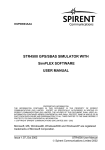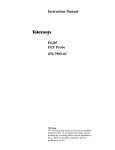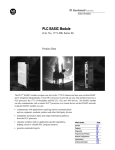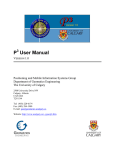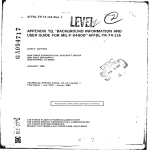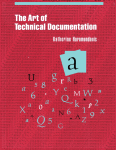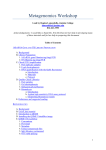Download Achieving 20cm Positioning Accuracy in Real Time Using GPS – the
Transcript
20 Achieving 20cm Positioning Accuracy in Real Time Using GPS – the Global Positioning System by E. MASELLA, B.Eng., P.E. Marconi Canada Marconi Canada (part of the Marconi North America Group of Marconi Electronic Systems) is a recognized world leader in the design, manufacĆ ture, sale and support of highĆtechnology elecĆ tronic products for the aerospace and communications market, for both military and commercial applications. Its headquarters and principal design and manufacturing facility is located in StĆLaurent, Quebec (in the greater Montreal area). Its facilities include a branch plant in Kanata, Ontario (in the Ottawa area), as well as sales and service offices across Canada. A photoĆ graph of the Company's headquarters is presented in fig. 1. Marconi Canada is a pioneer in the design and manufacture of GPS receivers. The first receiver development took place in the early 1980s with a military receiver development for the Canadian Department of National Defence. Then, in the midĆ1980s, the first commercial GPS receiver was developed. The next major development took place in the early 1990s for a GPS receiver to be installed on the new Boeing 777 aircraft. This marked the beginning of a series of successes for Marconi Canada in the commercial avionics market, and the Company is now recognized as a world leader in this area. In the midĆ1990s, a new group was created with the objective of porting our GPS technology on lowĆcost hardware platforms. This initiative has been a success as well, with the development of a variety of products targeted towards the consumer 1 The headquarters of Marconi Canada Erik Masella gained his bachelor's degree in Electrical Engineering at the University of Sherbrooke in 1991. In 1992 he joined the Aerospace Group of Marconi Canada and has been involved in the design and test of airborne GPS software and GPSĆaided landing systems. In 1996 he joined the GPS OEM Group. Since then he has been involved in the development of new GPS products for the consumer market. He is a chartered Professional Engineer. (EĆmail: [email protected]) Glossary ASIC Application Specific Integrated Circuit DGPS Differential Global Positioning System FEPROM Flash Erasable Programmable ReadĆOnly Memory IF Intermediate Frequency I/O Input/Output OEM Original Equipment Manufacturer PVT Position, Velocity and Time RF Radio Frequency RISC Reduced Instruction Set Computer RTK RealĆTime Kinematic UART Universal Asynchronous Receiver/Transmitter market, namely: automatic vehicle location systems, marine navigation, golf yardage systems, surveying systems, and also some military applications requiring commercial offĆtheĆshelf (COTS) solutions. Introduction to GPS The NAVSTAR (NAVigation Satellite Timing And Ranging) Global Positioning System, better known as GPS, is a radionavigation system using a network of satellites distributed over six orbital planes. GPS provides accurate 3ĆD position, velĆ ocity and time information, and worldĆwide 24Ćhour coverage to an unlimited number of users with allĆweather operation. GPS is a oneĆway ranging system: signals are transmitted only by the satellites. Each GPS satellite transmits signals centred on two microwave frequencies: 1575.42ĂMHz, referred to as Link 1, or simply L1; and 1227.60ĂMHz, referred to as L2. The L1 signal is modulated with (i) the Coarse Acquisition (or C/A) Code, a coarse ranging signal; (ii) the Precise (P) Code, a precise, but encrypted, ranging signal; and (iii) navigation data at 50 bits per second. L2 is modulated only GEC REVIEW, VOL. 14, NO. 1, 1999 ACHIEVING 20CM POSITIONING ACCURACY IN REAL TIME USING GPS 21 with the PCode and the navigation data. Auth orized users only (U.S. Department of Defense and allies) have access to the decryption keys of the PCode, which by its nature has much higher anti jamming properties than the C/ACode. Using the ranging signal and the navigation data, a GPS receiver can measure the range between the satellite and the receiving antenna, and compute the exact position of the transmitting satellite. Hence, with three satellites, the 3D position of the receiver may be computed, and a fourth is required for solution of the time. An excellent overview of the GPS system operation is given in reference (1). Code Differential GPS Overview Code Differential GPS (Code DGPS) is the regular Global Positioning System with the addi tion of a differential signal that conveys correction data. These data significantly increase the accu racy of the GPS navigation function and can be broadcast over any authorized communication channel. In these systems, a GPS receiver is located at a known (surveyed) position: this receiver is usually referred to as a reference sta tion. The reference station makes measurements on the satellite's signal and estimates the measure ment errors using its surveyed geodetic position. The errors include the signal transmission delays caused by the ionosphere and the troposphere, as well as Selective Availability (S/A) - an intentional signal degradation introduced by the U.S. Depart ment of Defense, in an effort to restrict the accuracy capability of most civilian GPS users. In layman's terms, because the reference station knows precisely where it is and computes a differ ent position using the GPS signals, it can estimate the errors in its signal measurements. These errors, or differential corrections (that is, the difference between the true range and the measured range), are then transmitted to roving receivers by radio or other means. They can then be applied to GPS measurements from the roving GPS receiver, and used to remove the systematic (correctable) error factors, because most of these errors will be similar for the roving receivers. Note that the correlation factor between errors observed at both sites largely depends on the distance between the two receivers. A DGPS system therefore consists of at least two units: a reference station and one (or several) roving units. The reference station broadcasts its differential data and the roving units receive it through a data port, directly connected to a radio receiver. The roving units can then display position, velocity, time (PVT) and other information, as needed for their marine, land or aeronautical 2 Code Differential Global Positioning System (DGPS) example applications. A DGPS system implementation is depicted in fig. 2 (note that the reference station is located on the ground and the roving unit is located in the aircraft). Carrier Differential GPS Overview A different, and more accurate, differential correction technique involves tracking of the satel lite signal's carrier phase, and is called carrier phase DGPS. When a receiver navigates in carrierphase mode, it is measuring a different GPS observable, namely the GPS carrier wave. To do so, it must measure the phase of the carrier continuously from signal lock time, t0, in order to produce the following observable: t f m(t) + f(t + t 0) ) ŕ fdt, (1) t0 where f is the received carrier phase and f is the received Doppler frequency. In order to produce a range measurement between the satellite and the user, the following observable must then be formed: (2) ò f(t) + N 0 ) f m(t), where N0 is an exact number of cycles between the user and the satellite at time t0. fm thus represents the change in cycles since time t0. However, the initial number of wavelengths N0 between the satellite and the receiver is unknown. This is called the carrier phase ambiguity and must be estimated. In order to estimate this ambi guity, it is necessary for the roving GPS unit to use information (that is, carrierphase measurements) from a reference station. This technique yields accuracies in the cmrange in dynamic environ ments and is called 'Realtime Kinematic', or RTK, GPS. A rather good (albeit brief) introduction to code and carrierphase DGPS is presented in reference (2). GEC REVIEW, VOL. 14, NO. 1, 1999 22 E. MASELLA System Specifications The RTKcapable engine developed by Marconi Canada, called the RT•Star, consists of singlefrequency (L1) RTK Navigation software residing on a lowcost hardware platform for embedding in Original Equipment Manufacturer (OEM) systems. It measures 4 2.65 (100mm 67mm) and consumes 2W. Details of its use, performance and specifications are presented in reference (3). This product is considered to possess one of the highest accuracy overprice ratios in the OEM sensor industry. The RT•Star can be configured either as a reference station or a roving unit via a command message. Communication between both is implemented via a standard radio link and the information is encoded in RTCM104 format(4). Communication from a host computer with the GPS engine is performed via a serial port using an RS232 Marconiproprietary transmission proto col. The reference station is also capable of self surveying its position. The RT•Star has the following features: S S S S S S S S S 12 parallel tracking channels; GPS measurements sampling aligned on GPS time onesecond rollover event; raw measurement output rate of 10Hz; time mark signal output aligned on GPS time onesecond rollover event; keepalive input pin (RAM and/or realtime clock); dual UART (third UART optional); six input/output discrete control lines; reprogrammable operational code (FEPROM); and rechargeable lithium battery (optional). The RT•Star is compatible with both active and passive antennas. System Architecture Hardware Overview The RT•Star hardware is a highly integrated design built around three components(5): S RF frontend, S digital signal processing (DSP) ASIC, and S RISC processor. Fig. 3 depicts a block diagram of the receiver. The RF chip, preceded by a lownoise amplifier (LNA), performs a triple IF conversion, from Receiver block diagram 3 1575.42MHz to 4.3MHz, and a 2bit analog todigital conversion. The temperaturecontrolled crystal oscillator (TCXO) is the receiver's reference oscillator. The DSP chip includes a 12channel GPS signal correlator and the following peripheral circuits: S two programmable UARTs; S realtime clock; S S programmable interrupts; watchdog and reset circuit; and S discrete I/Os. The processor is the system's critical component. The ARM60 RISC processor was selected because it has: S S S the processing power to handle 12 tracking channels; 30% spare capacity for customerspecific tasks; and low cost and power consumption. Software Overview The embedded software was developed using objectoriented design and programming techniques in order to yield reusable software components and to encapsulate the functions most subject to change. The major objects encapsulate the following functionalities: S Signal Processing; S S Satellite List Management; I/O Management; S Differential Data Processing; and S Navigator. The Navigator is the ultimate recipient of the work produced by the other objects: it receives all the data (measurements, differential data, satellite data...) and produces a PVT estimate. GEC REVIEW, VOL. 14, NO. 1, 1999 ACHIEVING 20CM POSITIONING ACCURACY IN REAL TIME USING GPS Navigator Overview A comprehensive description of the Navigator's algorithms is presented in reference (6). Only a brief overview is presented below. One of the first steps to be performed in an RTK Navigation solution is to form two sets of observ ables: the single and the doubledifferences(2). Both are derived using the carrier phase observ able, which is defined as: ò f + R ) c(Dt u * Dt s * Diono ) Dtropo) ) å orbit)N 0l)h f , (3) where: R is the true range between satellite and user; c Dt is the speed of light; u Dt s is the satellite's clock offset, including relativistic effects; Dtropo is the total tropospheric delay; is the error introduced by the orbital data; is the initial carrier phase ambiguity; l is the signal's wavelength (19cm for L1); and is the error caused by the receiver thermal hf noise; it is a Gaussian process with zero mean. Note that in eqn. (3), R is the true range between the satellite and the user. Geometrically, this can be expressed as: R + Ǹ(x s * x u) 2)(y s * y u) 2)(z s * z u) 2 , (4) s s s where x , y , z are the satellite's coordinates as provided by the satellite's navigation data and x u, y u, z u are the unknown user's coordinates. A singledifference across satellites is defined as the instantaneous difference in the carrier phase measurement made by the same receiver observ ing two satellite signals simultaneously. The singledifference operator is denoted as ʼn. From n satellites (n-1) singledifferences can be formed. The simplest way of forming these (n-1) observ ables is by selecting a reference satellite, s*, and applying the operator ʼn as follows: ʼnf si,s* + f usi * f us*, (5) where f represents the phase measurement by the user of satellite i. u si Expanding eqn. (5) using eqn. (3) shows that the receiver clock errors are removed in the resulting singledifference observable. To form the next observable, a doublediffer ence, a set of (n-1) singledifferences must be formed with measurements from the roving user. Hence a set of (n-1) singledifferences are formed with measurements received by the reference station on the differential link. A doubledifference would read as follows: (6) Dʼnf r,siu,s* + ʼnf rsi,s* * ʼnf usi,s*. The property of this observable is that satellite clock errors are removed. Expansion of eqn. (6) with eqns. (3) and (5) yields an equation in which the unknowns are: DʼnR, is the user's clock offset from true time; Diono is the total ionospheric advance (the dispersive property of the ionosphere on the carrier actually causes an advance of the signal with respect to the modulated code); å orbit N0 23 the value of the geometric distance of the doubledifference across satellites and receivers; Dʼniono , the value of the double advance of the carrier because of the ionosphere across satellites and receivers; Dʼntropo , the value of the doubledifferenced delay of the carrier because of the troposphere across satellites and receivers; DʼnN 0 , the doubledifferenced ambiguity expressed in cycles (it is itself an integer since it is the algebraic sum of four integers); Dʼnå orbit , Dʼnh f , the value of the doubledifferenced orbital errors across satellites; and the doubledifferenced phase noise (the sum of four Gaussian processes with zero mean). Because Dʼnh f may be neglected if the receiver has relatively low phase noise, as well as Dʼnå orbit (beyond the scope of this text), and because Dʼniono and Dʼntropo may be modelled, only DʼnN 0 remains to be properly estimated in order to solve for R. Fortunately, N0 is a constant, hence it may be estimated over time using the carrier phase observables. So, as we can see, a set of synchronized carrier phase measurements (that is, measurements that are sampled at the same time) from the reference station and the roving unit is required at the latter. One problem which arises is that the data link that provides the carrier measurements from the refer ence station has a given transmission latency. Consequently, the roving unit will receive its reference measurements with a typical latency of 1 to 2 seconds. Because a Navigation solution is required for the current time, the roving unit will have to have some means of extrapolating the GEC REVIEW, VOL. 14, NO. 1, 1999 24 E. MASELLA reference measurements for the current time (that is, coincident with the unit's measurement time); then timematched doubledifferences can be produced. This extrapolation process is implem ented using PositionVelocityAcceleration (PVA) tracking filters, which are not discussed here, but interested readers may find details on these filters in reference (7). One realizes that the estimated state vector X is composed of two basic sets of parameters: X = {User Model | Measurement Model} The observability on these two sets is quite differ ent. The user model represents the dynamics of the roving user. This set must be updated at the basic rate of the Navigator. However, the measurement model builds its observability on the change of geometry of the satellites that compose the unknown ambiguity. A fast update rate will not significantly improve the observability on the measurement model because of the high accuracy of the carrier phase measurements. The Navigation function is therefore separated into two processes: S a Kalman filter that acts upon reference station and roving unit measurements sampled at the same time. Because of the data link latency, this solution is typically old by a few seconds. This filter is referred to herein as the `OffLine Filter'; and S a Kalman filter that acts upon extrapolated reference station measurements and roving unit measurements sampled for the current time. The update rate of this filter is currently at 1Hz. It is referred to herein as the `OnLine Filter'. These findings therefore suggest that the purpose of the OffLine Filter is to estimate the ambiguity vector (measurement model) in the background. Because the dynamics of the ambiguities are very small (they tend towards constants), this filtering can be executed at a rate significantly lower than the required navigation rate. The OnLine Filter is thus used to provide user PVT estimates at the nominal navigation rate. It will use the ambiguity vector computed by the OffLine Filter. Sample reset test 4 Repeatability and convergence time were tested by forcing a system reset every 20 minutes over a period of 24 hours. A sample of one reset test is shown in fig. 4. The reset times are marked with a cross on the time axis. It is observed that the system repeatedly converges towards zero error. Table 1 shows some statistics generated from the results. The 3D r.m.s. error reaches 20cm after approximately 7 minutes. TABLE 1 Reset Tests Statistics Time after reset (minutes) North r.m.s. error (cm) East r.m.s. error (cm) Vertical r.m.s. error (cm) 5 23 8 12 10 8 6 8 20 7 3 6 Kinematic Tests Static Tests Two types of kinematic tests were performed: A series of tests was carried out using three surveyed antennas located on Marconi Canada's roof, in order to establish the accuracy, conver gence time and functional behaviour of the RT•Star in static mode. S GPS signal simulator tests to verify the absolute accuracy of the solution; and S field tests to verify reallife accuracy and functionality of the system. GEC REVIEW, VOL. 14, NO. 1, 1999 ACHIEVING 20CM POSITIONING ACCURACY IN REAL TIME USING GPS Simulator test set-up 5 GPS Signal Simulator Tests The purpose of the simulator test was to verify the accuracy of the RT•Star in a normal dynamic environment. Two Nortel model STR2760 GPS sig nal simulators were set up in differential mode to carry out this test. Fig. 5 depicts the test setup. The test simulates an aircraft performing dynamic manuvres. The scenario is as follows: 25 Simulator test position errors 6 tests were performed using a reference station located on the Company's roof and a vehicle equipped with an antenna and an RT•Star. The vehicle followed a route located in an urban zone with a surveyed geodetic marker situated on the route. The test procedure is as follows: S the antenna is fixed to a surveying rod set on top of a geodetic marker located in front of the Company building; S system is poweredon and remains static for 2 minutes; S the aircraft is static for 10 minutes; S it accelerates linearly with a 1g acceleration up to 100m/s; S it climbs to an altitude of 1km; S S it then completes a square path at a constant speed of 100m/s with 10 minutes between each turn; the antenna is relocated on the vehicle's roof (the operator triggers a signal that logs the time at which the antenna is removed); S S it touches ground and decelerates to 0m/s; and the vehicle drives around the Company site and stops at the geodetic marker; S it remains static for 5 minutes. S the antenna is removed from the rooftop and set on top of the marker (the operator triggers a signal that logs the time at which the antenna is set); S the antenna remains static for approximately 2 minutes, the operator triggers the removal time log and relocates the antenna on the vehicle. The position solution generated in real time by the RT•Star was logged and then compared to the truth file of the simulator, which is a file containing the true vehicle position at each GPS second. The results were processed with the MATLABt data analysis tool (provided by the MathWorks Inc.) and the NorthEastDown position errors are presented in fig. 6. Field Tests The purpose of these tests was to verify the accuracy and the functionality of the RT•Star in a reallife environment. Several kinematic baseline The above routine was repeated ten times. Fig. 7 shows the position in the vertical plane. The red marks on the time axis represent the periods at which the antenna was located on the survey point. It is observed that repeatable results are obtained at each run. GEC REVIEW, VOL. 14, NO. 1, 1999 26 E. MASELLA 8 Horizontal position error on survey point 7 Vehicle vertical difference The error in the horizontal plane of the computed position of the marker at each run is presented in fig. 8. Conclusions The tests conducted on the RT•Star show that 20cm positioning accuracy can be obtained in real time using GPS. Furthermore, the results have been proven to be repeatable. The RT•Star (fig. 9) is considered an excellent tradeoff between lowcost code differential GPS systems delivering 1metre accuracy levels and highend twofrequency RTK systems offering an accuracy level of only a few centimetres. It is suited for a variety of applications, namely precision agriculture, aircraft positioning and machine control. It also gives the user the flexibility to confi gure the receiver either as a reference station or a roving unit via a command message. the IEEE Position Location and Navigation Symposium `98 in April 1998 at Palm Springs, CA, USA, and published in the conference proceedings. References 1 MILLIKEN, R.J. and ZOLLER, C.J., `Principle of operation of NAVSTAR and system characteristics', Global Positioning System, Journal of the Institute of Navigation, 1, pp. 314, 1980. 2 LANGLEY, R.B., `RTK GPS', GPS World, pp. 7076, September 1998. 3 RT•Star User's Manual, ver. 001, Canadian Marconi Company publication no. 1220GEN0101, February 1998. 4 RTCM Recommended Standards for Differential NAVSTAR GPS Service, ver. 2.1, RTCM Special Committee104, January 1994 5 T HÉROUX , Y., `Open architecture design for GPS applications', Proceedings of the ION GPS95, The 8th International Technical Meeting of The Satellite Division of the Institute of Navigation, pp. 117121, 1995. 6 MASELLA, E., GONTHIER, M. and DUMAINE, M., `The RT•Star: features and performance of a lowcost RTK OEM sensor', Proceedings of the ION GPS97, The 10th International Technical Meeting of The Satellite Division of the Institute of Navigation, pp. 5359, 1997. 7 R AMACHANDRA , K.V., M OHAN , B.R. and G EETHA , B.R., 'A threestate Kalman tracker using position and rate measurements', IEEE Transactions on Aerospace and Electronic Systems, 29, 1, pp. 215221, January 1993. Acknowledgement This paper is based on a presentation, entitled `Precise Kinematic Positioning Experiments with a LowCost RTK GPS Engine', given by the author at GEC REVIEW, VOL. 14, NO. 1, 1999 ACHIEVING 20CM POSITIONING ACCURACY IN REAL TIME USING GPS 9 27 The RTSStar smart antenna unit: an RTSStar (shown inset) embedded in a GPS antenna GEC REVIEW, VOL. 14, NO. 1, 1999








